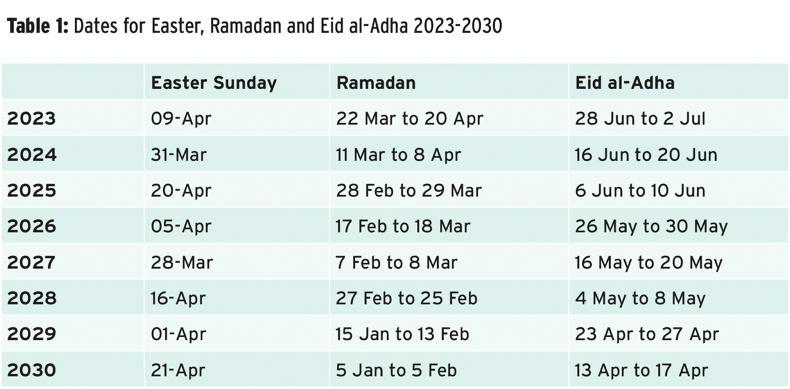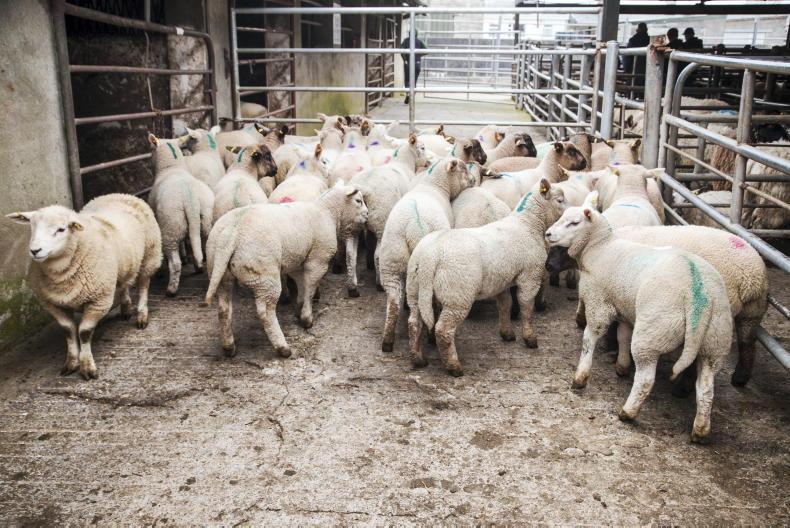The profile of Irish farmgate sheep prices generally follows a relatively flat trend line for the second half of the year. This means that when it comes to developing a breeding policy, market dynamics should in general be well down the list of objectives.
When it comes to market trends in the first half of the year, the volatile nature of returns and high cost means that there is no major enticement for farmers to bring forward their lambing date to try and take advantage of the higher returns.
However, for farmers which are in a system of producing lambs in the first half of the season for whatever reason, be this operating a pedigree flock, exploiting available facilities and labour or out of preference, then tweaking the breeding policy to try and target a higher demand may be advantageous.
Religious festivals
The dynamics of supply and demand dictate market returns and in terms of sheepmeat, there are three main religious festivals, Easter, Ramadan and Eid al-Adha, which have a significant influence. The dates of all three festivals change. Easter typically falls from late March to mid-April, as detailed in Table 1.
The two Islamic festivals of Ramadan and Eid al-Adha take place on the same date on the Islamic calendar. This, however, is a shorter annual calendar, spanning 354-355 days compared with the Gregorian calendar, which is 365-366 days.
Hence, the date of the two festivals on the Gregorian calendar move forward each year by 11 days. This means that the festivals will take place at an earlier date each year, as also detailed in Table 1.
For the last five years, the start or end of the month-long festival of Ramadan has taken place within one to two weeks of Easter. This has increased demand, but it has not always delivered a significant lift in price, with an oversupply of hoggets in the market in certain years, meaning there was no discernible change in price.
Where this has occurred, it has still delivered a benefit by taking sheepmeat out of the system, which has helped the trade in the post-festival period.
Ramadan delivers a significant boost in demand at the start and end of the festival, whereas buying for the Eid al-Adha festival is condensed into a week-to-10-day intensive period.
The festival has underpinned the highest levels of weekly throughput over the last five years and has often in this timeframe delayed the seasonal decline in farmgate returns.

Focus sheep breeding page 47
Additional factors
Producers targeting the marketing of lambs for Easter and Ramadan need to be mindful of later lambing dates, leading to higher numbers of hoggets being carried in to the subsequent year. This was very evident in 2022, with the hogget kill rising by 200,000 head and again in 2023, with a further increase of 80,000 hoggets.
There are also other additional factors that could alter the performance of markets. Australia’s free trade agreement with the UK affords them a tariff-free quota of 14,726t in 2023 and this jumps to 30,556t in 2024.
With Australian lamb trading at the start of July at an equivalent farmgate price of below €3.50/kg and the country exporting record volumes of sheepmeat, then there is a risk that there will be higher volumes of Australian sheepmeat in the system.
A downturn in Chinese sheepmeat imports has also left New Zealand sheepmeat exports more exposed, with 50% of exports destined for that market.
New Zealand have refocused their attention to the UK and EU markets in the last 18 months, with import volumes running 20% to 30% higher. Combined with consumption challenges in the UK, these factors could see higher volumes of UK sheepmeat coming on to the EU market. These factors must be considered before making any significant changes to your farm’s breeding policy.
The profile of Irish farmgate sheep prices generally follows a relatively flat trend line for the second half of the year. This means that when it comes to developing a breeding policy, market dynamics should in general be well down the list of objectives.
When it comes to market trends in the first half of the year, the volatile nature of returns and high cost means that there is no major enticement for farmers to bring forward their lambing date to try and take advantage of the higher returns.
However, for farmers which are in a system of producing lambs in the first half of the season for whatever reason, be this operating a pedigree flock, exploiting available facilities and labour or out of preference, then tweaking the breeding policy to try and target a higher demand may be advantageous.
Religious festivals
The dynamics of supply and demand dictate market returns and in terms of sheepmeat, there are three main religious festivals, Easter, Ramadan and Eid al-Adha, which have a significant influence. The dates of all three festivals change. Easter typically falls from late March to mid-April, as detailed in Table 1.
The two Islamic festivals of Ramadan and Eid al-Adha take place on the same date on the Islamic calendar. This, however, is a shorter annual calendar, spanning 354-355 days compared with the Gregorian calendar, which is 365-366 days.
Hence, the date of the two festivals on the Gregorian calendar move forward each year by 11 days. This means that the festivals will take place at an earlier date each year, as also detailed in Table 1.
For the last five years, the start or end of the month-long festival of Ramadan has taken place within one to two weeks of Easter. This has increased demand, but it has not always delivered a significant lift in price, with an oversupply of hoggets in the market in certain years, meaning there was no discernible change in price.
Where this has occurred, it has still delivered a benefit by taking sheepmeat out of the system, which has helped the trade in the post-festival period.
Ramadan delivers a significant boost in demand at the start and end of the festival, whereas buying for the Eid al-Adha festival is condensed into a week-to-10-day intensive period.
The festival has underpinned the highest levels of weekly throughput over the last five years and has often in this timeframe delayed the seasonal decline in farmgate returns.

Focus sheep breeding page 47
Additional factors
Producers targeting the marketing of lambs for Easter and Ramadan need to be mindful of later lambing dates, leading to higher numbers of hoggets being carried in to the subsequent year. This was very evident in 2022, with the hogget kill rising by 200,000 head and again in 2023, with a further increase of 80,000 hoggets.
There are also other additional factors that could alter the performance of markets. Australia’s free trade agreement with the UK affords them a tariff-free quota of 14,726t in 2023 and this jumps to 30,556t in 2024.
With Australian lamb trading at the start of July at an equivalent farmgate price of below €3.50/kg and the country exporting record volumes of sheepmeat, then there is a risk that there will be higher volumes of Australian sheepmeat in the system.
A downturn in Chinese sheepmeat imports has also left New Zealand sheepmeat exports more exposed, with 50% of exports destined for that market.
New Zealand have refocused their attention to the UK and EU markets in the last 18 months, with import volumes running 20% to 30% higher. Combined with consumption challenges in the UK, these factors could see higher volumes of UK sheepmeat coming on to the EU market. These factors must be considered before making any significant changes to your farm’s breeding policy.







 This is a subscriber-only article
This is a subscriber-only article











SHARING OPTIONS: